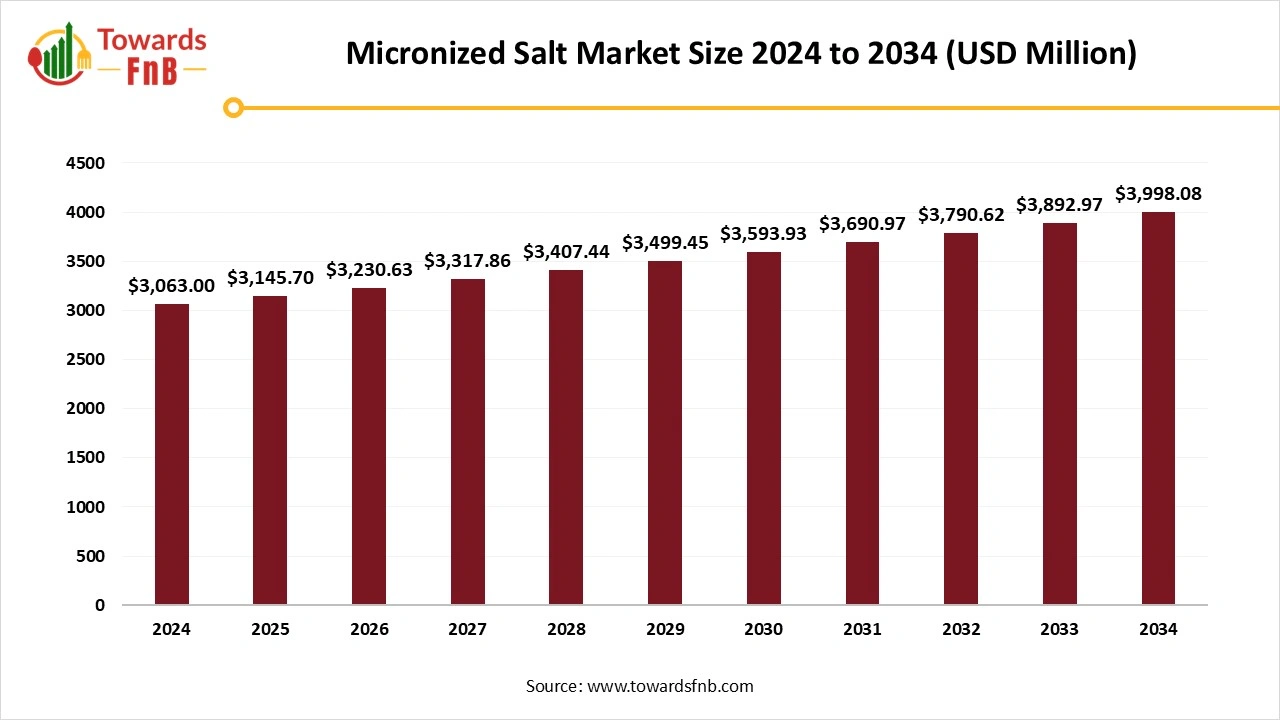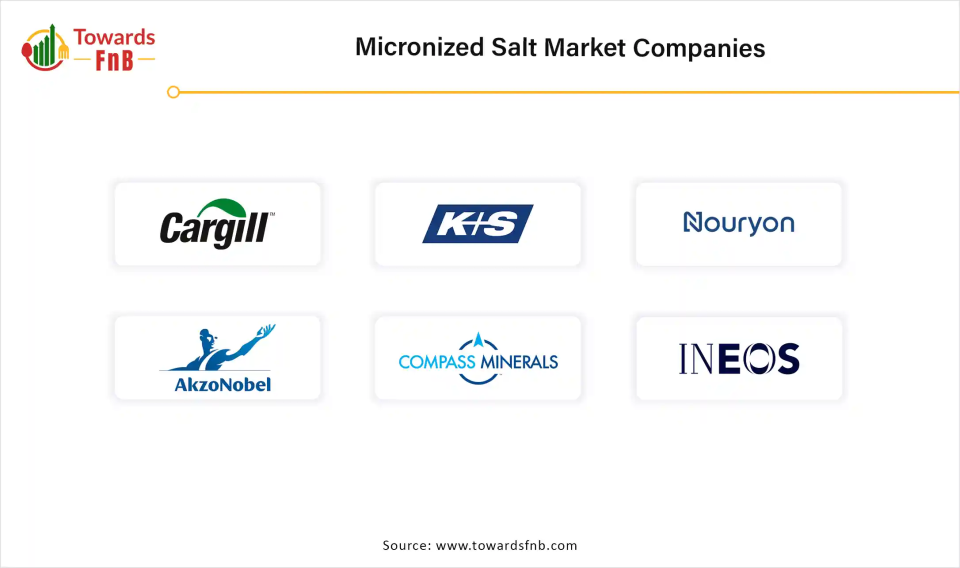December 2025
The global micronized salt market size was estimated at USD 3,063 million in 2024 and is expected to rise from USD 3,145.70 million in 2025 to nearly reaching USD 3,998.08 million by 2034, growing at a CAGR of 2.7% during the forecast period from 2025 to 2034. The rising research and development activities in salt processing technologies drives the growth of the market.

| Study Coverage | Details |
| Growth Rate from 2025 to 2034 | CAGR of 2.7% |
| Market Size in 2025 | USD 3,145.70 Million |
| Market Size in 2026 | USD 3,230.63 Million |
| Market Size by 2034 | USD 3,998.08 Million |
| Largest Market | Asia Pacific |
| Base Year | 2024 |
| Forecast Period | 2025 to 2034 |
| Regions Covered | North America, Europe, Asia-Pacific, Latin America, and Middle East & Africa |
Micronized salt market refers to ultra-fine salt particles (typically <100 microns), produced through mechanical milling or specialized crystallization methods. These salt are used in industries where high solubility, uniform distribution, and surface contact are essential, such as food processing, pharmaceuticals, personal care, industrial applications, and more. Their fine particle size enhances functionality such as absorption, flowability, and quick dissolution.
One of the significant factors driving the growth of the market is the increasing demand for processed food. The increasing demand for packaged and processed foods is accelerating the need for high-quality salt, particularly pharmaceutical and micronized-grade salt. These salts are highly utilized in spice blends, instant mixes, ready meals, and snacks to prevent clumping, dissolve quickly, and enhance flavors. Various food manufacturers depend on fine-particle salt, as more consumers choose ready-to-eat and convenient foods to ensure shelf life, texture, and better taste, which is further expected to fuel the growth of the market.
The global market is expected to experience rapid expansion as industries rapidly identify the value of finely milled salt in improving consumer satisfaction, performance, and product quality. The rising technological advancements of regulatory requirements, technological advancements dietary preferences, may create major opportunities and will continue to shape the market dynamics for market differentiation and innovation among salt manufacturers and producers across the globe.
In addition, the integration of micronized salt into consumer applications and diverse industrial uses, as consumer awareness of micronized salt benefits increases, which is expected to revolutionize the industry development and micronized salt market in the coming years.
One of the major restraining factors hindering market growth is increasing competition from alternative salt products. The market for micronized salt faces various challenges from various alternative salt products, including Himalayan pink salt, sea salt, and rock salt. These salts offer perceived health benefits, textures, and unique flavors, which can reduce the demand for micronized salt and appeal to consumers looking for premium and variety options, which may hinder market growth. In addition, the increasing popularity of these additives' salts may reduce market growth from micronized salt, especially in the specialty and gourmet food segments, which is further expected to restrain the growth of the micronized salt market.
How Asia Pacific Dominates the Micronized Salt Market Revenue in 2024?
Asia Pacific dominated the micronized salt market revenue in 2024. The market growth in the region is attributed to the increasing adoption of micronized salt in food processing, increasing consumption of ready-to-eat foods, increasing demand for processed foods, and increasing rapid urbanization and industrialization. China, India, Japan, and South Korea are dominating countries driving the market growth in the region.

India dominated the market revenue in 2024, driven by the increasing demand for packaged foods, increasing awareness towards health and wellness, increasing consumption of sodium consumption, and increasing demand for meat in the country. With rising meat consumption in India, about 80% of sodium consumption is derived from packaged and processed foods, which is expected to fuel the market growth in India.
Middle East & Africa is Expected to Grow Fastest During the Forecast Period.
The global micronized salt market growth in the region is attributed to the Increasing demand for gourmet food, increasing consumer shift towards artisanal production, rising technological advancements in food processing, increasing consumer preference towards texture and purity, and increasing demand from chemical and food, and beverage industries.
How did Vacuum Salt Segment Held the Largest Micronized Salt Market Revenue in 2024?
The vacuum salt segment dominated the micronized salt market revenue in 2024. Vacuum salt increases as a necessary tool in the huge landscape of water treatment, which offers an effective and innovative approach to improve the clarity and quality of foods. This is a versatile ingredient that can be utilized in various types of recipes. Vacuum salt is a versatile and high-quality ingredient that offers major benefits such as purity, health benefits, and longer shelf life, which make it a valuable ingredient to any pantry or kitchen. Vacuum salt is highly beneficial for professional chef for high-quality ingredients and home cooking to add flavor to their dishes, which is expected to accelerate the demand for vacuum salt in the global market.
The Brine-Derived Salt Segment is Expected to Grow Fastest During the Forecast Period.
The brine-derived salt is a mixture of water and salt that can be sprayed on walkways, parking lots, and on roads, especially before an ice or snowstorm, to avoid the ice and snow from sticking to the surface. In addition, the growth of the brine-derived salt is driven by various benefits such as distributed more evenly, it can stay exactly where the consumer puts it, can work immediately, cost-effective option, is easy to handle, works at lower temperatures, and is safer for animals and people, which contributes to propelling the segment growth.
Why 40-70 Microns Segment Dominates the Micronized Salt Market Revenue in 2024?
The 40-70 microns segment dominated the micronized salt market revenue in 2024. The segment growth in the global market is driven by the increasing demand in emerging countries, increasing use in various industries such as textile finishing, dyes, and water treatment, increasing preference in blends and seasoning, improved flowability and solubility, and increasing demand for ideal texture for food applications. These microns are suitable for seasoning mixes, baked products, and snacks. Due to its consistent flavor enhancement, these microns are widely used in ready meals, instant soups, bouillon cubes, and spice mixes, which further accelerates the demand for 40-70 microns in the market.
The Below 10 Microns Segment is Expected to Grow Fastest During the Forecast Period.
The below 10 microns are large to remove viruses and bacteria, also remove finer sediment and dirt than 50-micron or 25-micron filters. They can help in various industries, such as oil, chemical, food industries, and more. In addition, it removes visible contaminants, debris, and coarse sediment particles. It helps to increase the lifespan of downstream filtration ingredients and provides pre-filtration for other water treatment systems, including UV disinfection and reverse osmosis, which is further expected to enhance the market growth in the global market.
What Factors Help Food Grade Segment Grow in 2024?
The food grade segment dominated the micronized salt market revenue in 2024. The segment growth in the global market is attributed to the increasing need for quality and shelf-life, increasing government initiatives and programs, growing food industry automation, increasing demand for uniform micronized textures and low-sodium salts, and increasing demand for processed food. In addition, the food grade helps to purify and process micronized salt to address quality, purity, and strict safety standards for human consumption. Furthermore, due to its widespread use in culinary applications and food processing, food grade is the largest segment in the market.
The Pharmaceutical Grade Segment is Expected to Grow Fastest During the Forecast Period.
The segment growth in the global micronized salt market is driven by factors such as the increasing rapid use of medical and personal care products, increasing growth in generic pharmaceuticals, growing geriatric population, and increasing demand for IV Fluids and ORS. In addition, pharmaceutical grade helps in fine-particle and high-purity salt that addresses regulatory standards and strict medical regulations in personal care, healthcare, and pharmaceutical sectors, which is further expected to fuel segment growth.
How Flavor Enhancer Segment Dominates Micronized Salt Market Revenue in 2024?
The flavor enhancer segment dominated the market revenue in 2024. Flavor enhancer play an important role in the food industry across the globe. Flavor enhancers are an important part of the dining experience, from enhancing the taste of food to improving its nutritional value. Flavor enhancers are highly used in food processing and make meals nutritious and enjoyable. In addition, flavor enhancers can help to minimize the presence of salt and other seasonings and enhance the nutritional value of food.
The Anticaking Agent Segment is Expected to Grow Fastest During the Forecast Period.
Anticaking agents are commonly found in mixed coffee beverages, cocoa, table salt, baking powder, flour-based mixes, and milk and cream powders to enhance the meal. During the packaging process, the anticaking agents help to avoid bridging in manufacturing, which can minimize production rates, which is expected to accelerate the demand for anticaking agents in the market.
What Factors Help Food & Beverage-Snacks Segment Grow in 2024?
The food and beverage segment dominated the micronized salt market revenue in 2024. The segment growth in the global market is driven by factors such as the increasing consumer trend towards organic and clean-label products and increasing demand for ready-to-drink and on-the-go beverages. Under this segment, the snacks segment held the largest market share, driven by the increasing growth in packaged snacks, rising technological advancements in the seasoned variants and flavor, increasing consumer awareness, and increasing consumption of on-the-go and ready-to-eat snack food.
The Pharmaceuticals Segment is Expected to Grow Fastest During the Forecast Period.
The segment growth in the micronized salt market is attributed to the increasing growth of pharmaceutical manufacturing in emerging regions, increasing health awareness, and increasing demand for geriatric and pediatric needs. Under this segment, the oral rehydration salt segment expects the fastest growth in the market, driven by the increasing government health initiatives such as UNICEF, WHO, and more, and increasing prevalence of dehydration diseases, such as viral fevers, gastrointestinal infections, and heatwaves.
How Direct/B2B Segment Dominates Micronized Salt Market Revenue in 2024?
The direct/B2B segment dominated the micronized salt market in 2024. The segment growth in the global market is attributed to the increasing consumer desire to purchase micronized salt and related food products without waiting for delivery, increasing consumer preference towards offline stores, increasing demand for in-store marketing and promotional activities, and increasing consumer trust towards manufacturers and producers. The direct/B2B segment is convenient for shopping for food products, especially snacks. It has an extended shelf life. Consumers can feel more satisfied while shopping offline with these channels, which is further expected to fuel segment growth in the market.
The Online Platforms Segment is Expected to Grow Fastest During the Forecast Period.
The segment growth in the market is propelled by factors such as increasing consumer trend towards online shopping, growing e-commerce platforms, rising internet penetration, increasing busy and modern lifestyles and increasing demand for ready-to-eat and on-the-go snacking options.
Department of Nutrition and Food Safety (NFS)
Hershey Company

By Source Type
By Particle Size
By Purity Grade
By Functionality
By Application Industry
By Distribution Channel
By Region
December 2025
December 2025
December 2025
December 2025